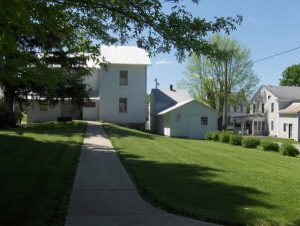History of the Penns Valley Area Historical Museum Property

Many owners of an old house wish to discover something about the previous owners of their property. As an example, the house recently purchased by the museum association is nearly two hundred years old. Some questions naturally come to mind; Who lived there? What did they do for a living? What kind of world did they live in? What decisions did they have to make? Was the owner also the primary resident or did renters live there? How old are the current outbuildings? This article contains the results of my preliminary investigation.
Lot number 410 was just one of over six hundred long, marrow, quarter-acre lots in Aaron Levy’s 1786 town plan. Levy, hoping to establish Aaronsburg as a future county seat (not a state capital), used a marketing technique still common today; he reserved several lots for public buildings such as schools and churches.
(The reader should note two other interesting details. Levy initially sold lots in town through a statewide lottery. This was a common practice used to promote settlement in the eighteenth century. The other fact is that the grid pattern of streets and alleys laid out by Levy is a town plan typical of the time.)
This sixty-foot by two hundred-foot undeveloped parcel was obtained by Simon Gratz (Levy’s eventual heir) from Aaron Levy in 1802. Twelve years later, Gratz sold the lot to John Hess for $100.00.
Water company records, tax records and deed transfers indicate that Hess, a hatter, erected the eastern half, a Georgian-style log structure, on the site in 1817. A wood-frame addition came several years later. By 1820 the census shows one male over twenty-six years of age living in the Hess household, as well as one male between sixteen and twenty-six, another between ten and sixteen, and two males under the age of ten. Some of these males may have been apprentices or workers in Hess’s business.
By 1860, Frederick Rager (also spelled Reager and Taeger), a carpenter, and his wife were living in the house. When Rager’s widow, Margaret, died thirty years later, the estate sale listed, among the other items, a broom machine. This may indicate that either Rager worked at this trade in his spare time or in his old age. (It may also have been long-unused equipment inherited from a relative, such as a father-in-law.)
Rager’s friend, W.B. Mingle, administered the estate and had the “two story dwelling house, stable and other outbuildings” sold to Henry and Carrie Detwiler for $600 in 1893. Two days later, the Detwilers transferred the property to Harriet and Emanuel Wetzel, a daughter and son-in-law of a John Hess (the original owner?).
The Wetzels then sold the house for $680 to W.A.J. and Catura Korman, “residents of Wolf’s Store,” in 1895. The Kormans, seven years later, sold the property to Thomas C. and Sally Weaver for $525. The Weavers owned the place until February 1919, when they sold it to J.A. Grenoble for $800.
Grenoble sold the place to David Sparr Wert in March of 1923 for $1670. Title then transferred to Wert’s grandson, Douglas Vonada, upon Wert’s death sixty-four years later.
The cursory examination of the outbuildings reveals several interesting details. While the barn contains the original logs, there are posts and other structural elements indicating that additions were cobbled from other buildings. This was a common practice in the late nineteenth and early twentieth century because large-scale, commercial logging was stripping away many of the old-growth trees around here. New construction techniques, such as balloon framing, were developed to adjust to this reality.
The shed housing the agricultural exhibit yields a date of June 1933 in the concrete floor. This building itself, however, is a classic post-and-beam structure with board-and batten siding, and most likely dates from the 1890s as well.
We hope to discover and present more answers to our questions about this place, its history and its owners and information comes to light. We welcome any information our readers may have about the property or the families listed in this article.










